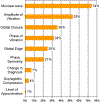Utility of Laryngeal High-speed Videoendoscopy in Clinical Voice Assessment
- PMID: 28596101
- PMCID: PMC6814298
- DOI: 10.1016/j.jvoice.2017.05.002
Utility of Laryngeal High-speed Videoendoscopy in Clinical Voice Assessment
Abstract
Objective: This study aimed to assess the utility of laryngeal high-speed videoendoscopy (HSV) as a clinical tool.
Design: This is a prospective study of 151 patients.
Methods: A total of 151 adult patients (52 male, 99 female) underwent both videoendoscopy with stroboscopy (videostroboscopy) and HSV examination as part of a routine clinical voice assessment. At the time of the examination, ratings for videostroboscopy were reported in the clinical report. Next, the clinicians reviewed the HSV examination and indicated the changes in ratings of HSV relative to videostroboscopy. Finally, the clinical reports were reviewed by a clinician not involved in data collection or clinical care of the patients and noted differences between videostroboscopy and HSV clinical ratings, and resulting diagnoses were identified and grouped.
Results: Ratings of all vibratory features showed change between videostroboscopy and HSV. Mucosal wave and amplitude of vibration showed the largest percentage change, respectively, in 74% and 53% of the reports. They were followed by the features of glottal closure (36%), phase closure (32%), glottal edge (25%), and phase symmetry (21%). Ratings of supraglottic compression and vocal fold vertical level showed the least change between videostroboscopy and HSV. Changes in initial diagnosis owing to the inclusion of HSV were indicated in 7% of the cases.
Conclusions: HSV may be an important laryngeal imaging technique for functional assessment of the pathophysiology of certain voice disorders. HSV could enable important refinements in the diagnosis and management of vocal fold pathology.
Keywords: High-speed videoendoscopy; Videostroboscopy; Vocal-fold vibration; Voice assessment; Voice disorders.
Copyright © 2018 The Voice Foundation. Published by Elsevier Inc. All rights reserved.
Figures
Similar articles
-
Efficacy of Videostroboscopy and High-Speed Videoendoscopy to Obtain Functional Outcomes From Perioperative Ratings in Patients With Vocal Fold Mass Lesions.J Voice. 2020 Sep;34(5):769-782. doi: 10.1016/j.jvoice.2019.03.012. Epub 2019 Apr 17. J Voice. 2020. PMID: 31005449 Free PMC article.
-
Quantitative assessment of videolaryngostroboscopic images in patients with glottic pathologies.Logoped Phoniatr Vocol. 2017 Jul;42(2):73-83. doi: 10.3109/14015439.2016.1174293. Epub 2016 May 2. Logoped Phoniatr Vocol. 2017. PMID: 27132636
-
Real-time Simultaneous DKG and 2D DKG Using High-speed Digital Camera.J Voice. 2017 Mar;31(2):247.e1-247.e7. doi: 10.1016/j.jvoice.2016.08.005. Epub 2016 Nov 7. J Voice. 2017. PMID: 27839706
-
Objective Measures of Stroboscopy and High-Speed Video.Adv Otorhinolaryngol. 2020;85:25-44. doi: 10.1159/000456681. Epub 2020 Nov 9. Adv Otorhinolaryngol. 2020. PMID: 33166979 Review.
-
Objective measures of laryngeal imaging: what have we learned since Dr. Paul Moore.J Voice. 2014 Jan;28(1):69-81. doi: 10.1016/j.jvoice.2013.02.001. Epub 2013 Oct 2. J Voice. 2014. PMID: 24094798 Review.
Cited by
-
Comparative Evaluation of High-Speed Videoendoscopy and Laryngovideostroboscopy for Functional Laryngeal Assessment in Clinical Practice.J Clin Med. 2025 Mar 4;14(5):1723. doi: 10.3390/jcm14051723. J Clin Med. 2025. PMID: 40095862 Free PMC article.
-
Influence of spatial camera resolution in high-speed videoendoscopy on laryngeal parameters.PLoS One. 2019 Apr 22;14(4):e0215168. doi: 10.1371/journal.pone.0215168. eCollection 2019. PLoS One. 2019. PMID: 31009488 Free PMC article.
-
Reconstruction of Vocal Fold Medial Surface 3D Trajectories: Effects of Neuromuscular Stimulation and Airflow.Laryngoscope. 2024 Mar;134(3):1249-1257. doi: 10.1002/lary.31029. Epub 2023 Sep 6. Laryngoscope. 2024. PMID: 37672673 Free PMC article.
-
Machine learning based identification of relevant parameters for functional voice disorders derived from endoscopic high-speed recordings.Sci Rep. 2020 Jun 29;10(1):10517. doi: 10.1038/s41598-020-66405-y. Sci Rep. 2020. PMID: 32601277 Free PMC article.
-
Lombard Effect in Individuals With Nonphonotraumatic Vocal Hyperfunction: Impact on Acoustic, Aerodynamic, and Vocal Fold Vibratory Parameters.J Speech Lang Hear Res. 2022 Aug 17;65(8):2881-2895. doi: 10.1044/2022_JSLHR-21-00508. Epub 2022 Aug 5. J Speech Lang Hear Res. 2022. PMID: 35930680 Free PMC article.
References
-
- Awan S, Barkmeier-Kraemer J, Courey M, Deliyski D, Eadie T, Svec J, Patel R, Hillman R, Paul D (2014). Standard Clinical Protocols for Endoscopic, Acoustic and Aerodynamic Voice Assessment: Recommendations from ASHA Expert Committee. Abstracts: Convention of the American Speech-Language-Hearing Association. Orlando, Florida, November 20–22, 2014
-
- Deliyski D Laryngeal high-speed videoendoscopy In: Kendall KA, Leonard RJ,eds. Laryngeal Evaluation: Indirect Laryngoscopy to High-Speed Digital Imaging. New York, NY: Thieme Medical Publishers; 2010: 243–270.
-
- Patel R, Dailey S, Bless D (2008). Comparison of high-speed digital imaging with stroboscopy for laryngeal imaging of glottal disorders. Ann Otol Rhinol Laryngol, 117(6):413–424. - PubMed
-
- Deliyski D (2008). Clinical implementation of laryngeal high-speed videoendoscopy: Challenges and evolution. Folia Phoniatrica et Logopaedica, 60:33–44. - PubMed
-
- Kendall KA (2009). High-speed laryngeal imaging compared with videostroboscopy in healthy subjects. Arch Otolaryngol Head Neck Surg, 135(3):274–281. - PubMed
MeSH terms
Grants and funding
LinkOut - more resources
Full Text Sources
Other Literature Sources
Medical


